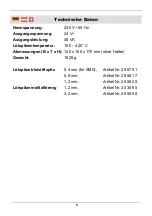
13
Operation
Take only electronic solder with resin or activated resin fluxes.
Do not use fluxes containing chloride or acid. Use always the
correct soldering temperature to avoid cold solder joints or
burned flux. If the temperature is too low the solder will not
flow correctly and will cause cold solder joints. If the tempera-
ture is too high the flux will be burned and not allow the solder
to flow. High temperature can also damage the board or other
sensitive components.
This table gives you some hints about the usual temperatures
for different soldering tasks:
Task
Recommended Soldering Temperature
Melting Point
215° C (depending on the used solder)
Standard Soldering
270
– 300° C
Industrial use
320
– 380° C
Desoldering (small joints)
315° C
Desoldering (large joints)
400° C
Switching Off
1. Let some solder melt on the tip after work. This protects the
soldering point from corrosion during storage.
2. Switch off the soldering iron station by pressing the ON/OFF
rocker switch and pull the power plug.
3. Place the iron into the iron holder and allow all parts to cool
down before storing.
Changing the Iron Tip
Allow the soldering iron to cool down to room temperature before
touching the tip of the heater. There is risk of burns!

































